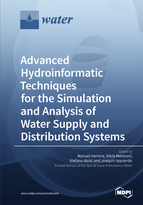Advanced Hydroinformatic Techniques for the Simulation and Analysis of Water Supply and Distribution Systems
A special issue of Water (ISSN 2073-4441). This special issue belongs to the section "Urban Water Management".
Deadline for manuscript submissions: closed (30 September 2017) | Viewed by 121123
Special Issue Editors
Interests: KDD; graph databases; environmental data mining; weather; hydroinformatics
Special Issues, Collections and Topics in MDPI journals
Interests: pipeline systems; advanced anomaly detection in pipe systems; transient dynamics analysis
Special Issues, Collections and Topics in MDPI journals
Interests: water demand modelling and forecasting; water consumption smart metering and end-uses characterization; optimal management of water distribution systems; leakage detection; transient analysis of water distribution systems
Special Issues, Collections and Topics in MDPI journals
Interests: mathematical modeling; knowledge-based systems; DSSs in engineering (mainly urban hydraulics)
Special Issues, Collections and Topics in MDPI journals
Special Issue Information
Dear Colleagues
The overall objective of this Special Issue is to improve knowledge on developing and using advanced simulation tools in water supply and distribution systems. The final aim is to propose a suitable framework supporting insightful hydraulic mechanisms to help the decision-making processes of water utility managers and practitioners. Contributions to this Special Issue, exploring new research avenues on urban hydraulics and hydroinformatics, will be of great value for both Academia and those water utility stakeholders. On top of this, important social benefits are expected from a number of research objectives that ultimately aim to guarantee a regular supply of clean water at the pressure and quality required at the network consumption points. These objectives include a wide spectrum of subjects, such as demand monitoring and forecasting; network sectorisation; innovative tools for water resources management; leakage detection; system maintenance; transient control; and consumer satisfaction assessment, among others.
Dr. Manuel Herrera
Assoc. Prof. Silvia Meniconi
Assoc. Prof. Stefano Alvisi
Prof. Joaquín Izquierdo
Guest Editors
Manuscript Submission Information
Manuscripts should be submitted online at www.mdpi.com by registering and logging in to this website. Once you are registered, click here to go to the submission form. Manuscripts can be submitted until the deadline. All submissions that pass pre-check are peer-reviewed. Accepted papers will be published continuously in the journal (as soon as accepted) and will be listed together on the special issue website. Research articles, review articles as well as short communications are invited. For planned papers, a title and short abstract (about 100 words) can be sent to the Editorial Office for announcement on this website.
Submitted manuscripts should not have been published previously, nor be under consideration for publication elsewhere (except conference proceedings papers). All manuscripts are thoroughly refereed through a single-blind peer-review process. A guide for authors and other relevant information for submission of manuscripts is available on the Instructions for Authors page. Water is an international peer-reviewed open access semimonthly journal published by MDPI.
Please visit the Instructions for Authors page before submitting a manuscript. The Article Processing Charge (APC) for publication in this open access journal is 2600 CHF (Swiss Francs). Submitted papers should be well formatted and use good English. Authors may use MDPI's English editing service prior to publication or during author revisions.
Keywords
-
graph-theoretical methods and complex and social network applications to support water supply system analyses
-
multi-agent systems, petri-networks, and evolutionary models for water system optimal management
-
water infrastructure resilience and its critical interdependencies, such as cyber-resilience and cyber-attacks detection
-
district metered area division and household water demand for several water efficiency scenarios
-
big data for water resources management in a climate change scenario
-
innovative techniques for pipe system planning and management









